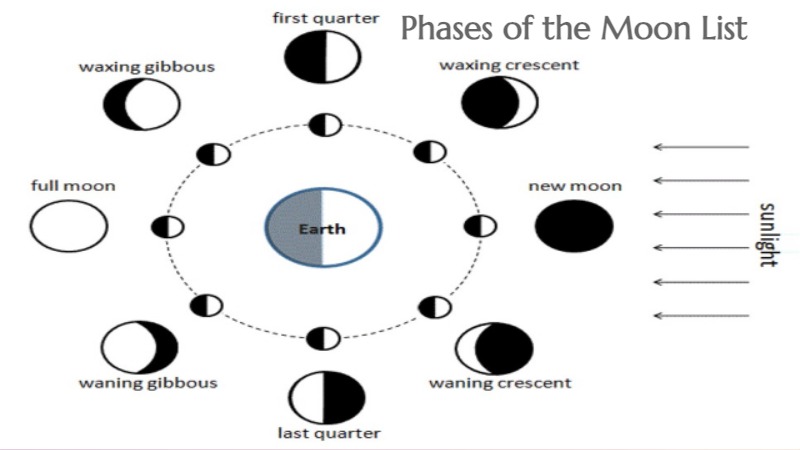
Phases of the moon list refers to 8 primary phases of moon based on its illuminated portion and visibility as it orbits around the Earth. It includes new moon, waxing crescent, first quarter, waxing gibbous, full moon, waning gibbous, last quarter, waning crescent. You can check the list of the eight primary phases of the moon in order of their occurence.
The phases of the Moon refer to the different appearances of the Moon as observed from Earth due to its changing position relative to the Sun.
8 Phases of the Moon List
- New Moon: The moon is not visible from Earth because the illuminated side is facing away from us. Disc is completely in Sun’s shadow (lit by earthshine only). It is invisible as it is too close to Sun except during a solar eclipse.
- Waxing Crescent: A small, crescent-shaped portion of the moon is visible, with the illuminated portion increasing each night. Northern hemisphere is on the right side (0 to 50%) lit disc while southern hemisphere is on the left side (0 to 50%) lit disc. Its visibility is from late morning to post-dusk.
- First Quarter: Half of the moon’s disk is visible, resembling a half-circle. This phase is also known as a half moon. Northern hemisphere is on the right side (50.1%) lit disc while southern hemisphere is on the left side (50.1%) lit disc. Its visibility is in afternoon and early night.
- Waxing Gibbous: More than half, but not all, of the moon is visible, and the illuminated portion continues to increase. Northern hemisphere is on the right side (50 to 100%) lit disc while southern hemisphere is on the left side (50 to 100%) lit disc. Its visibility is in late afternoon and most of night.
- Full Moon: The entire face of the moon is visible from Earth, as it is fully illuminated by the Sun. This is the brightest and most recognizable phase (100% illuminated disc). Its visibility is from sunset to sunrise (all night).
- Waning Gibbous: More than half, but not all, of the moon is visible, and the illuminated portion starts to decrease. Northern hemisphere is on the left side (100 to 50%) lit disc while southern hemisphere is on the right side (100 to 50%) lit disc. Its visibility is most of night and early morning.
- Last Quarter: Half of the moon’s disk is visible again, resembling a half-circle. This phase is also known as a half moon. Northern hemisphere is on the left side (50.1%) lit disc while southern hemisphere is on the right side (50.1%) lit disc. Its visibility is late night and morning.
- Waning Crescent: A small, crescent-shaped portion of the moon is visible, with the illuminated portion decreasing each night. Northern hemisphere is on the left side (50 to 0%) lit disc while southern hemisphere is on the right side (50 to 0%) lit disc. Its visibility is from pre-dawn to early afternoon.
It is worth noting that there are also intermediate phases within these primary phases, resulting in more detailed categorizations of the moon’s appearance throughout its cycle.
What is Waxing and Waning of Moon
The waxing and waning of the Moon refers to the gradual change in the Moon’s appearance as viewed from Earth. These changes occur due to the relative positions of the Sun, Earth, and Moon, which result in different portions of the Moon’s illuminated surface being visible to us. The lunar cycle, also known as the lunar month, is approximately 29.5 days long. It starts with the New Moon, where the Moon is positioned between the Earth and the Sun, with the side that is illuminated by the Sun facing away from us. During this phase, the Moon is not visible to us because the illuminated side is not facing Earth.
As the days progress, a thin sliver of the Moon becomes visible. This phase is called the Waxing Crescent. The amount of illuminated surface gradually increases each day until it reaches the First Quarter phase. At this point, half of the Moon’s visible surface is illuminated, resembling a half-circle. The Waxing Gibbous phase follows, during which the illuminated portion continues to grow until the Moon reaches the Full Moon phase. During a Full Moon, the Earth is positioned between the Moon and the Sun, and the entire side of the Moon facing Earth is fully illuminated.
After the Full Moon, the Moon starts to wane. The illuminated portion gradually decreases, leading to the Waning Gibbous phase. As the days progress, the illuminated area becomes smaller until it reaches the Third Quarter phase, where half of the Moon’s visible surface is again illuminated, but on the opposite side from the First Quarter. Finally, the Moon enters the Waning Crescent phase, where only a small, shrinking sliver of the illuminated surface is visible. This phase continues until it becomes too thin to see, and the cycle starts again with the New Moon.
Moon’s appearance can be affected by atmospheric conditions, such as clouds and pollution, which may impact visibility. Moreover, the exact timing and visibility of the Moon’s phases can vary slightly due to the Moon’s elliptical orbit and other factors, but the waxing and waning pattern remains consistent.










